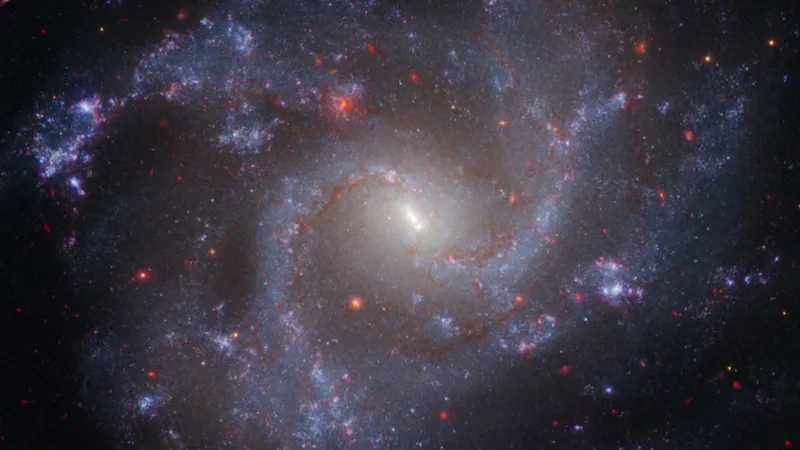
Revolutionary Space Mission: Satellites Set to Create an Artificial Solar Eclipse!
2024-12-12
Author: Olivia
Revolutionary Space Mission: Satellites Set to Create an Artificial Solar Eclipse!
Imagine witnessing a solar eclipse—where the moon slips perfectly between the Earth and the sun, blocking its brilliant light. Now, picture two spacecraft pulling off this celestial spectacle themselves. This dream is becoming a reality. Last week, the European Space Agency (ESA) successfully launched two innovative satellites aimed at creating an artificial solar eclipse, marking a thrilling milestone in space exploration.
What is Proba-3?
Dubbed Proba-3 (Project for On-Board Autonomy), this mission sets out to showcase cutting-edge technology called precise formation flying (PFF) while diving deep into the mysteries of the sun’s outer atmosphere, known as the corona. According to Ester Bastida, systems engineer at Proba-3, "Currently, the corona is a region of the sun that has been poorly investigated, and scientists do not fully understand many of the phenomena occurring there.” PFF will enable these satellites to mirror the moon's behavior by positioning themselves with remarkable accuracy to block out the sun's light.
The Mystery of the Corona’s Temperature
While the sun's surface sizzles at approximately 5,500 degrees Celsius (9,932 degrees Fahrenheit), the corona’s temperature is a staggering 1-3 million degrees Celsius (1.8-5.4 million degrees Fahrenheit). This raises a burning question: why is the corona so much hotter than the sun itself? This mission aims to find answers that could illuminate our understanding of solar dynamics and potentially improve space weather predictions.
How Will Proba-3 Create an Eclipse?
Launched on December 5 from the Satish Dhawan Space Centre in India aboard the PSLV-C59 rocket, Proba-3's two spacecraft will ascend approximately 60,000 kilometers (37,280 miles) above Earth. The Coronagraph Spacecraft (CSC) will work closely with the Occulter (OSC), a secondary spacecraft designed to cast a shadow. With a disk measuring 140 cm (55 inches) in diameter, the OSC will effectively block the sun’s intense light, giving the CSC a clear view of the corona.
Precision in Space
Precision is key; the two satellites will need to maintain a distance of precisely 150 meters (492 feet) apart to create an artificial solar eclipse for up to six hours. This requires millimeter-level accuracy, an incredible feat in the realm of space science.
What Are Scientists Looking To Discover?
One of the driving forces behind this mission is the demonstration of PFF technology, which utilizes GPS and radio links for positioning. Once separated, the two spacecraft will maintain formation, drifting 25-250 meters (82-820 feet) apart in perfect sync.
Equipped with advanced instruments, the Proba-3 will examine why the corona is hotter than the sun. One pivotal tool is a coronagraph—a sophisticated telescope that filters out the sun's glaring light. The Proba-3’s coronagraph, nicknamed ASPICCS (Association of Spacecraft for Polarimetric and Imaging Investigation of the Corona of the Sun), will simulate the conditions of a total solar eclipse with astonishing precision, free from the distortions of Earth’s atmosphere.
Why Is This Mission So Groundbreaking?
Typically invisible to our naked eye, the corona shines brighter than the sun's surface a million times over, appearing only during rare solar eclipses. Understanding the corona could enhance our ability to predict space weather and mitigate the effects of geomagnetic storms that disrupt satellites and communications on Earth.
Solar eclipses are a rare treat—most locations on Earth experience one only every 375 years, and they last just minutes. Proba-3, however, boasts a 19-hour and 36-minute orbital cycle. If this pioneering mission proves successful, researchers will unlock the ability to study the corona for six hours during each orbit, transforming our grasp of solar science.
Conclusion
Stay tuned as this space odyssey unfolds, potentially revolutionizing how we view our eternal solar companion! Will these pioneering satellites solve the sun's hottest mysteries? The countdown has begun!









 Brasil (PT)
Brasil (PT)
 Canada (EN)
Canada (EN)
 Chile (ES)
Chile (ES)
 España (ES)
España (ES)
 France (FR)
France (FR)
 Hong Kong (EN)
Hong Kong (EN)
 Italia (IT)
Italia (IT)
 日本 (JA)
日本 (JA)
 Magyarország (HU)
Magyarország (HU)
 Norge (NO)
Norge (NO)
 Polska (PL)
Polska (PL)
 Schweiz (DE)
Schweiz (DE)
 Singapore (EN)
Singapore (EN)
 Sverige (SV)
Sverige (SV)
 Suomi (FI)
Suomi (FI)
 Türkiye (TR)
Türkiye (TR)